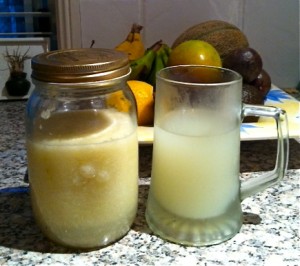Guest Writer for Wake Up World
Over the years my family and I have consumed many different fermented foods. Saurkraut we’ve made in large containers and ate in small amounts at lunch and dinner. Often I would eat it as a snack with organic baked corn chips. I love the sour flavour and the versatility of the recipes, experimenting with different vegetables to come up with unique flavours.
Then we went through a stage where Kombucha was king. This fermented drink, made with a mushroom like “pancake” was a fav with our now 10 year old and she always asked for her “beer”. Which is what it kind of looked like when sitting next to her father’s occasional brew.
Kombucha is a fermented tea and sugar drink which transforms into a sparkling sweet/sour drink that has many health benefits.
Yogurt has always been a mainstay, usually soy based though we’ve also enjoyed coconut based as well. When made at home it is more cost efficient and you can control the length of time to ferment it and thus the increased bacteria and nutrient profile as well as increasing the digestibility of the proteins.
Tempeh is a traditional Indonesian food made by splitting, cooking and fermenting soybeans. Fresh is best and easy to make, though it takes 30 hours to incubate. It is inoculated by a culture that forms fuzzy white/gray/black mycelium enzymes, which bind the beans together, creating a hardy, meaty, texture. When homemade it is rich in vitamin B12 and contains high amounts of protein, which is easy to digest.
Kefir is the newest addition in our kitchen though it has been around for a very long time. I never was interested due to the fact that it was milk based. The beneficial yeast and friendly bacteria does consume most of the lactose though so that it becomes easier to digest. We have successfully been making kefir with both soy and young coconuts and I am delighted with the results. Kefir is a cultured enzyme rich drink which is filled with the good micro organisms which are so important to your gut health. In fact, many people believe that it is far superior to yogurt!
Miso is a fermented paste made from soybean, barley or rice and is used traditionally in Japanese cooking to flavour soups or sauces. We love to drink miso soup but on toast it makes a great alternative to the not so healthy vegemite spread!
This is just a sampling of the fermented foods available.
Why all the fuss about fermented foods?
Fermented foods go through changes both on a biochemical level as well as an organoleptical level. Plainly put this means the nutrients and the overall characteristics of taste, flavour, texture and etc., were changed.
There are many health benefits of traditional fermented foods and most cultures have their own unique recipes. Due to the influence of the westernised diet and fast food these foods are no longer as prevalent as they used to be.
A shame really, as these foods have high concentrations of pro-biotic bacteria and other beneficial micro-organisms and can aid and build a strong immune system.
They can;
- Prevent constipation, colon cancer and osteoarthritis,
- Improve liver function
- Reduce serum cholesterol
- Prevent obesity and atherosclerosis
- Stimulate bone growth
- Lower high blood pressure
- They are anti carcinogenic
- And can aid in the healing of tuberculosis and herpes
The fermenting process increases the production of enzymes which make the foods easier to digest. Fermenting also increases nutrients within the food such as essential amino acids, vitamins and minerals. Fermented milk is said to be a great source of energetic B vitamins while fermented vegies are high in Vitamin C.
We hear a great deal about the good bacteria and the bad bacteria that lives in us. Lots of advertising monies are spent these days encouraging us to purchase probiotics in powdered or pill form yet making your own ferments is cheaper and gives you more protection. Not to mention the delicious food you are creating and eating.
A study done in 2000 which was led by Chitra N. Wenkadoon of the University of Alberta, Edmonton, showed that fermented milk products can kill helicobacter pylori (the ulcer causing bacteria) but that the beneficial bacteria alone cannot. This means that probiotic pills would have no effect but that homemade yogurt and kefir would.
Another argument for whole foods being superior to a fractionated or extracted food form.
One of the simplest ferments to make is the Cabbage Rejuvalac which when ready has a light, slightly fizzy, cabbage flavour. Not unpleasant at all, and that is good as I have lingering olfactory memories of my polish grandmothers kitchen!
Start with organic cabbage as conventional will retain much of what is sprayed on it even after leaving the ground. There are many pesticides, fungicides and etc. used on conventional crops with detrimental effects on land, water systems, wildlife, and us!
Recipe: Cabbage Rejuvalac
The recipe initially takes 3 days to sit but once you make the first batch, the next ones will only take 24 hours. A little glass will do you…make sure to take on an empty stomach. I have it lately before all of my meals.
SO, take 3 cups of fresh, coarsely chopped cabbage (red or green) and place in a blender with 1 1/2 cups of purified water. The rejuvelac does NOT like chlorinated water. Process until liquefied and pour into a clean glass jar.
Close with a lid and set in a quiet undisturbed place for 3 days. Strain off and enjoy.
This recipe makes enough for 1 person to enjoy for 1 day. Split it up before your meals. Make sure to reserve 1/4 cup for the next batch you make. Pour it into the fresh batch after liquefying it and this helps to expedite the process.
Sources
ncbi.nlm.nih.gov/pubmed/21092375
ncbi.nlm.nih.gov/pubmed/20600519
About the Author
Jeani-Rose Atchison is a health advocate, and home-schooling mother of five who also finds time to write about nutrition, whole foods and environmental concerns. She authored, Every Day Vegan – 300 recipes for healthful eating which is a mainstay in vegetarian kitchens. Atchison’s latest book, Food for Thought – Thought for Food is chock full of delicious whole food recipes. It also takes a controversial look at the food we eat today and the processes involved in bringing it to your table. Can your food make you ill? The answer may shock you!
To find out more go to Jeani-Rose’s Facebook page.

If you've ever found value in our articles, we'd greatly appreciate your support by purchasing Mindful Meditation Techniques for Kids - A Practical Guide for Adults to Empower Kids with the Gift of Inner Peace and Resilience for Life.
In the spirit of mindfulness, we encourage you to choose the paperback version. Delve into its pages away from screen glare and notifications, allowing yourself to fully immerse in the transformative practices within. The physical book enriches the learning process and serves as a tangible commitment to mindfulness, easily shared among family and friends.
Over the past few years, Wake Up World has faced significant online censorship, impacting our financial ability to stay online. Instead of soliciting donations, we're exploring win-win solutions with our readers to remain financially viable. Moving into book publishing, we hope to secure ongoing funds to continue our mission. With over 8,500 articles published in the past 13 years, we are committed to keeping our content free and accessible to everyone, without resorting to a paywall.







